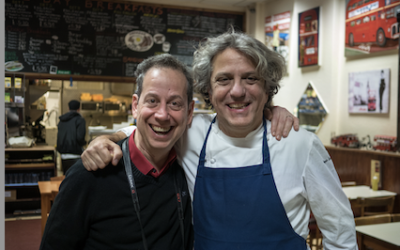 “As with any recipe,” writes Dino Joannides in his headnote introducing Spaghetti with Tomato and Basil, “success lies 75 percent in good-quality ingredients and 25 percent in execution.”
“As with any recipe,” writes Dino Joannides in his headnote introducing Spaghetti with Tomato and Basil, “success lies 75 percent in good-quality ingredients and 25 percent in execution.”
The maths may be problematic, leaving no room to credit the know-how, clarity and passion Dino puts into his recipes, but the point is clear: In Semplice: Real Italian Food, Dino’s newly published labour of love, ingredients come first. For Italians good food is made with good foods, it’s as simple as that.
But what are these good-quality ingredients? Who are the best producers? Where do you find them? It’s Dino’s informed answers to these questions that distinguish his work. Although I own some 35 books on Italian food Semplice nevertheless fills a big gap on my cookbook shelf.
Dino is one of the London food scene’s great characters, which is to say he is beyond characterisation. Much as I value this accomplished food blogger, home cook, gastronome, schmoozer and bon vivant both as friend and a dependable source of culinary intelligence I hate to answer the most asked question about him: What does @gastro1, to use his Twitter handle, actually do?
My best answer, that Dino dines, frustrates people. It explains everything and nothing. We all dine. It’s just that Dino does it better, and more often, than most of us. He approaches everything that ends up on his plate, or in his wine glass, as a purist. Whereas the Everest for other food explorers is typically absolute authenticity Dino mostly avoids that slippery climb. He is a diplomat who won’t delve into longstanding battles that pit village against village, grandmother against grandmother. His focus is grounded on the terroir.
When a food writer introduces a new cookbook to readers the common practice is to share a recipe. From Semplice I might’ve transposed the how-to for a regional classic – agnolotti filled with braised beef, perhaps, or Ossobuco alla Milanese.
In this instance I decided the best way to give you a lasting taste would be to excerpt some key ingredients instead. When I met Dino at a coffee shop near Piccadilly I asked for a list of Italian raw materials you had to have in your kitchen at all times, along with some recommended producers and sources.
As Dino enumerated the shopping list you see below an odd thing happened. Every so often the author had to consult the pages of his own book to answer a question or verify a detail. I viewed this recurring act as the ultimate endorsement: If @gastro1 himself could not manage without a copy of Semplice: Real Italian Food: Ingredients & Recipes at the ready how could we expect to do the same?
Dino’s Shopping List of Real Italian Food Essentials
 Extra Virgin Olive Oil 1
Extra Virgin Olive Oil 1
For your go-to extra virgin olive oil Dino recommends pungent, fruity, grassy olive oils from Tuscany. He particularly likes the oils from the estates of two wine producers, Tenuta de Capezzana and Fontodi.
Extra Virgin Olive Oil 2
For a more subtle finishing oil, the kind that sits on the table for drizzling atop vegetables or seafood Dino values the delicacy of a light EVOO from Liguria. The best oils from the region, like that of those of Cassini Vittoria, his preferred produced, are made with the prized taggiasca olive. It’s the olive and the oil you want for pesto genovese.
Balsamic vinegar
Genuine Balsamic vinegar is distinguished by its PDO – “Protected Designation of Origin” – status. Anything else, warns Dino, is not worth considering. He recommends Acetaia San Giacomo Aceto Balsamico Tradizionale di Reggio Emilio PDO and Acetaia Pedroni Aceto Balsamic Tradizionale di Modeno PDO.
Parmigiano Reggiano
For grating buy Parmigiano Reggiano PDO that has been aged for a least 24 months, ideally from a retailer or supplier who sells a lot of it. Cheese from a freshly cut wheel tends to be superior. Otherwise your default source for good Parmigiano Reggiano may be your supermarket.
Pecorino Romano
The pronounced saltiness of this hard ewes’ milk cheese is an essential in such Roman spaghetti classics as alla Carbonara, Cacio e Pepe and alla Griscia. Good Pecorino Romano PDO, such as Brunelli, is difficult to track down outside Italy.
Tomatoes
San Marzano tomatoes are prized for a taste that is fuller, sweeter and less acidic than most other varieties of plum or Roma tomatoes. For jars of San Marzanos with the DOP – “Denominazione Origine Protetta” designation Dino likes the producer I Sapori di Corbara. Tins (cans) of Strianese may, however, be easier to find in UK.
 Spaghetti (dry)
Spaghetti (dry)
For dry pasta Dino turns to the producers of Gragnano, a legally defined area in and around the Bay of Naples. He recommends the producers Pastificio dei Campi and Pastificio Sebastiano D’Apuzzo or, for outstanding value, the Gragnano pasta with the Tesco Finest label.
Linguine (dry)
Long pastas spaghetti and linguine are NOT interchangeable, says Dino. One is round, the other is flat. They couldn’t be more different.
Guanciale
Dino urges us not to substitute pancetta (salt-cured pork belly) for guanciale (salt-cured pigs’ jowls and cheeks), as many do. The pleasure of guanciale goes beyond the taste of cured meat itself. Its rendered fat is an essential cooking fat in several dishes.
Culatello
Dino regards Culatello di Zibello PDO as the king of salumi and a rival to the likes of prosciutto crudo and Jamón Ibérico for greatest cured meat in the world.
‘Nduja
The spicy and spreadable pork salumi of Calabria. Buy it whole or in portions and slice at home.
House Red
Villa di Capezzana (80% Sangiovese, 20% Cabernet Savignon)
House White
Argiolas Costamolino Vermentino di Sardegna DOC





0 Comments